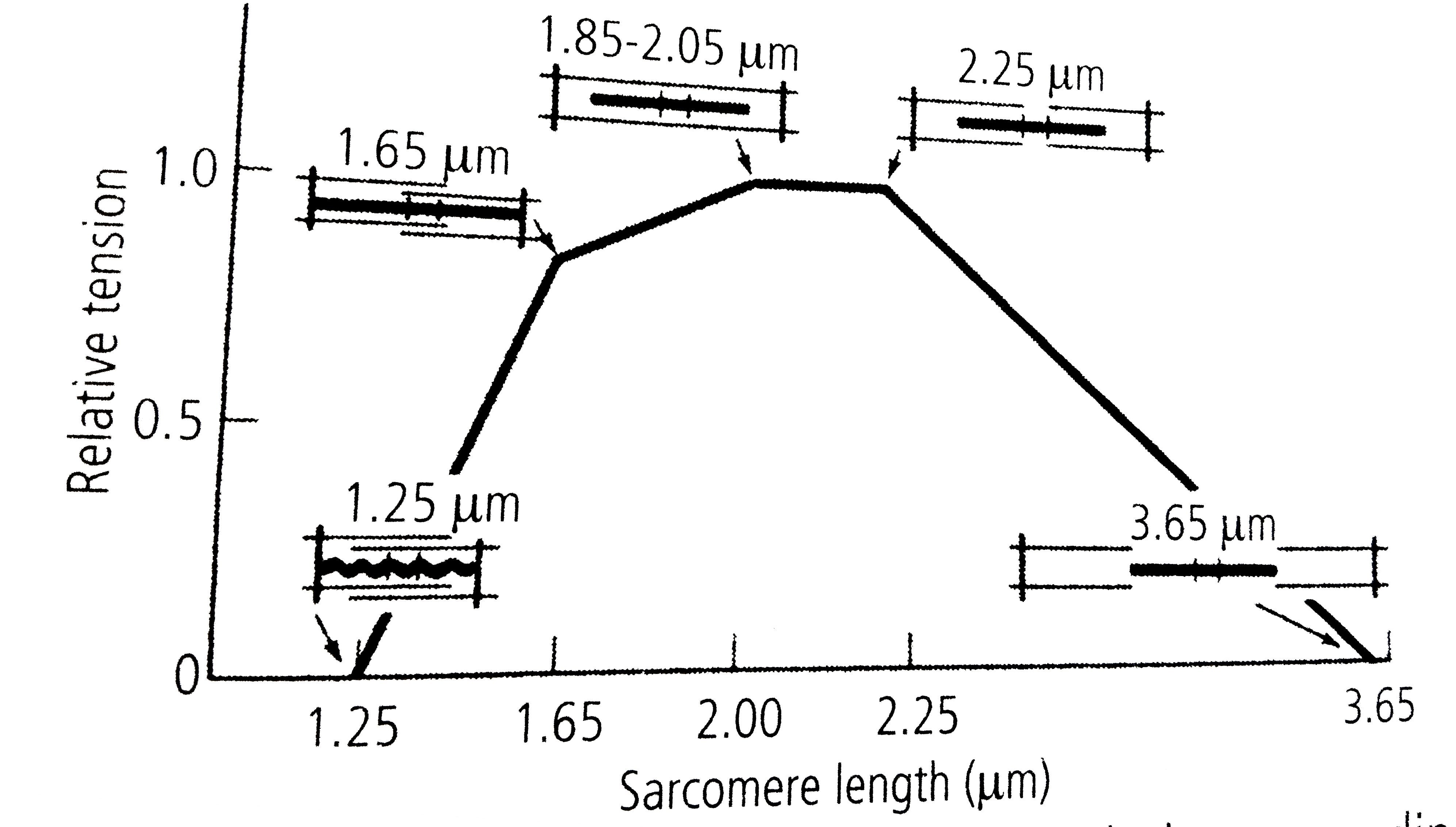At rest, when muscle is relaxed, thin filaments interdigitate with thick filaments only
Outside A- band
Outside H- band
Inside A- band
Inside M-line
The correct Answer is:B
To answer the question regarding the position of thin filaments interdigitating with thick filaments when the muscle is at rest and relaxed, we can follow these steps:
1. Understanding Muscle Structure:
- Muscles are made up of myofibrils, which contain thick (myosin) and thin (actin) filaments. The arrangement of these filaments is crucial for muscle contraction and relaxation.
2. Identifying Key Bands:
- The A band is the region where thick filaments (myosin) are present, and it also includes the overlapping area with thin filaments (actin).
- The H zone (or H band) is the central part of the A band where there are only thick filaments and no overlapping thin filaments.
3. Analyzing the Relaxed State:
- When the muscle is relaxed, the thin filaments do not overlap significantly with the thick filaments. The overlap occurs primarily outside the H zone.
- In the relaxed state, the thin filaments extend into the A band but do not reach the center (H zone) where only thick filaments are present.
4. Determining the Overlap Location:
- Since the thin filaments interdigitate with the thick filaments outside the H zone, we can conclude that the correct answer to the question is that the thin filaments overlap with the thick filaments outside the H band.
5. Choosing the Correct Option:
- Based on the analysis, the correct answer is Option B: outside H band.
Final Answer:
The thin filaments interdigitate with thick filaments outside the H band when the muscle is at rest and relaxed.
---
- Muscles are made up of myofibrils, which contain thick (myosin) and thin (actin) filaments. The arrangement of these filaments is crucial for muscle contraction and relaxation.
- The A band is the region where thick filaments (myosin) are present, and it also includes the overlapping area with thin filaments (actin).
- The H zone (or H band) is the central part of the A band where there are only thick filaments and no overlapping thin filaments.
- When the muscle is relaxed, the thin filaments do not overlap significantly with the thick filaments. The overlap occurs primarily outside the H zone.
- In the relaxed state, the thin filaments extend into the A band but do not reach the center (H zone) where only thick filaments are present.
- Since the thin filaments interdigitate with the thick filaments outside the H zone, we can conclude that the correct answer to the question is that the thin filaments overlap with the thick filaments outside the H band.
- Based on the analysis, the correct answer is Option B: outside H band.
The thin filaments interdigitate with thick filaments outside the H band when the muscle is at rest and relaxed.
Topper's Solved these Questions
- LOCOMOTION AND MOVEMENTBOOK - AAKASH INSTITUTE ENGLISHCHAPTER - LOCOMOTION AND MOVEMENTEXERCISE - ASSIGNMENT SECTION-A
35 Videos
- LOCOMOTION AND MOVEMENTBOOK - AAKASH INSTITUTE ENGLISHCHAPTER - LOCOMOTION AND MOVEMENTEXERCISE - ASSIGNMENT SECTION-B
25 Videos
- LOCOMOTION AND MOVEMENTBOOK - AAKASH INSTITUTE ENGLISHCHAPTER - LOCOMOTION AND MOVEMENTEXERCISE - TRY YOURSELF
59 Videos
- HUMAN REPRODUCTIONBOOK - AAKASH INSTITUTE ENGLISHCHAPTER - HUMAN REPRODUCTIONEXERCISE - Try Yourself
19 Videos
- MICROBES IN HUMAN WELFAREBOOK - AAKASH INSTITUTE ENGLISHCHAPTER - MICROBES IN HUMAN WELFAREEXERCISE - Assignment (SECTION - D Assertion - Reason Type Questions)
10 Videos
Similar Questions
Knowledge Check
The given graph shows length-tension curve for a typical vertebrate sarcomere.

By analysing the graph, what can you deduce regarding the muscle contraction?
(i) Neither the myosin filaments nor the actin thin filaments change in length when a sarcomere shortens or is stretched. Instead, it is the extent of ocerlap between actin and myosin filaments that changes.
(ii) The total tension produced by a sarcomere is proportional to the total number of cross-bridges that can interact with actin filaments, and this number in turn is proportional to the amount of of overlap between thick and thin filaments.
(iii) The tension produced by the muscle is maximal when the overlap between thick and thin filamentss allows the largest number of myosin cross-bridges to bind to actin.
(iv) Tension drops off with increased lenght, because the thick and thin filaments overlap less and fewer cross-bridges can bind.
Tension drops off with decreased length, because thin filaments at the two ends of the secromere begin to collide with each other, preventing further shortening.A(i) OnlyB(i),(iii) and (iv)C(i),(iii),(iv) and (v)D(i),(ii),(iii),(iv) and (v)Assertion: Mechanism of muscle contraction is expalained by sliding-filaments theory.
Reason: Contraction of muscle fibre takes place by the sliding of thick filaments over the thin filaments.AIf both assertion and reason are ture and reason is the corect explanation of assertionBIf both assertion and reason are ture but reson is not the correct explanation of assertionCIf assertion is true reason is falseDIf both assertion and reason are false
Actin is present in thin filaments.
View SolutionWhich is thick filament of muscle
View SolutionIn the region of A-band of a myofibril of a skeletal muscle where thick and thin filaments overlap. each thick filament is surrounded by
View SolutionAssertion : Contraction of a muscle fibre takes place by the sliding of the thin filaments over the thick filaments.
Reason : The central part of thick filament is not overlapped by thin filaments in a resting state.
View SolutionStatements
A-bands of the muscle are dark and contain myosin
I-band are the light bands and contain action
During muscle contration the A-band contracts
The part between the two Z-lines is called as saromere
The central part of thin filament, not over-lapped by thick filament is called H-zone of the above statements.
View SolutionWhich protein is present in thick flament and thin filament ?
View Solution
